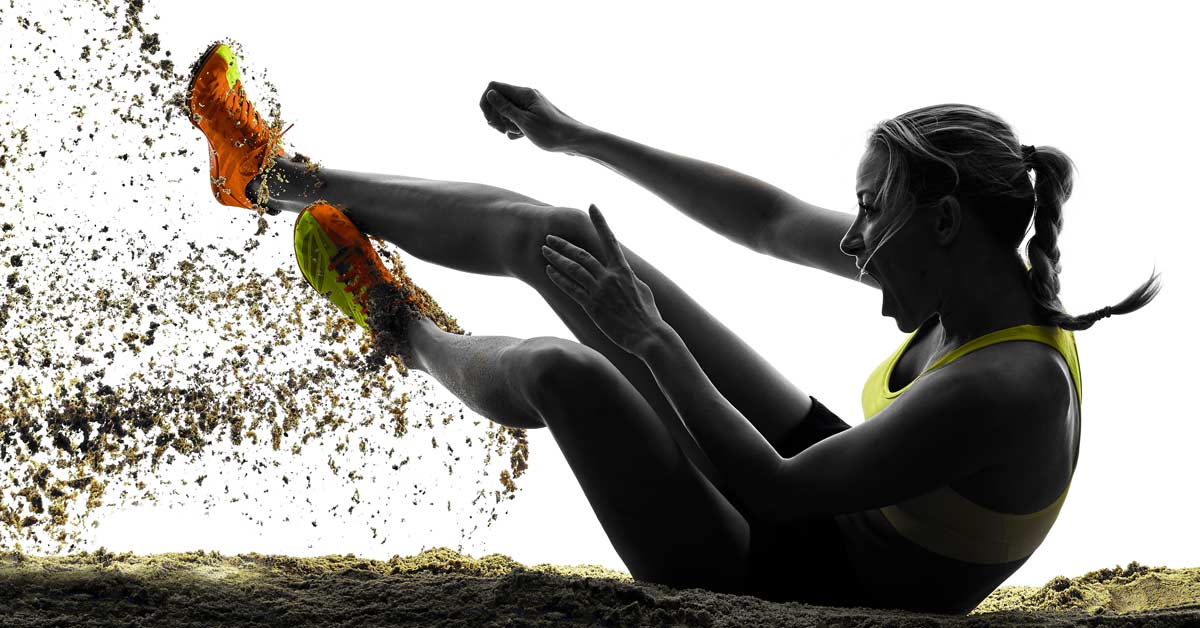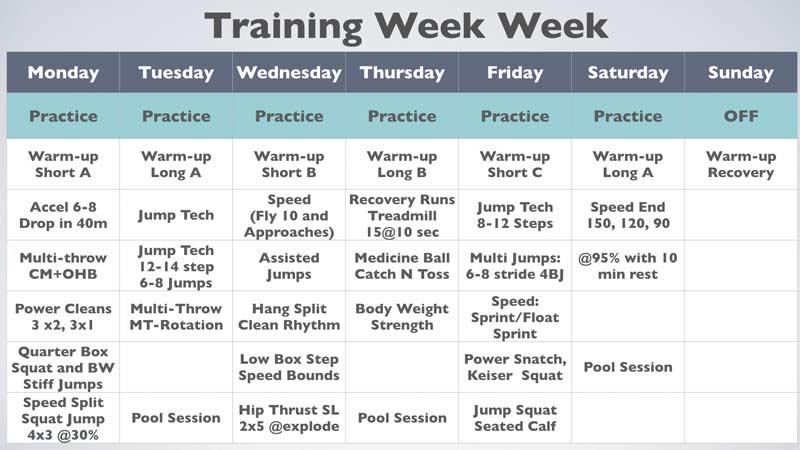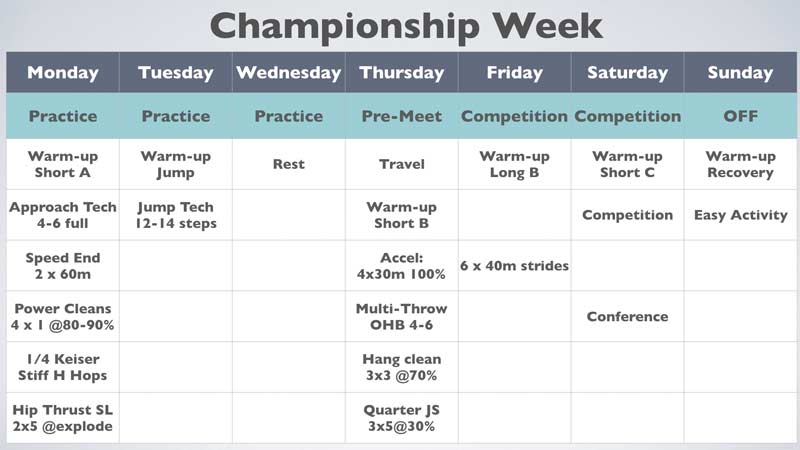[mashshare]
Nick Newman is Assistant Track & Field Coach at The University of California, Berkeley. Before joining UC Berkeley, Nick dedicated 10 years to the study and application of the development of athletes ranging from pre-adolescent youth to the professional ranks.
Freelap USA: Horizontal speed is a primary factor in all of the jumps. Could you share some of the common mistakes you see with high school and college jumpers in regard to training? While most coaches would agree that speed matters, there’s a good chance that when you see programs or talk to athletes, what we know to be optimal is not always followed.
Nick Newman: I’ll preface these answers by saying that elite performance can be achieved through almost any type of program, good or bad. There have been and always will be superstar talents that emerge from very poorly run programs or coaching philosophies. Unfortunately, these instances tend to validate programming flaws and interfere with coach development.
When superstar talents emerge from poorly run programs, it tends to validate programming flaws, says @CoachNickNewman. Share on XI’ve listed the common errors I see in HS and college jumps programs.
Tempo/Endurance-Based Programming
I can’t tell you how many high school recruits have told me they don’t sprint during practice, with the majority of their “sprinting” ranging from repeat 200s to 500, 400, 300, 200 breakdowns.
What benefit is there for a jumper doing multiple 200m-based workouts each week?
The odd superstar talent can probably get away with this approach and still jump well. However, for 90% of the group, this programming will kill any potential speed gains that could benefit performance on the runway.
The difference between approach speed and 100m speed as it relates to the horizontal jumps needs to be understood. Fast on the runway isn’t always especially fast on the track. For example, a relatively mediocre male athlete running 11.2-11.5 seconds for the 100m COULD have more than enough ability to run a fast fly 10m.
These athletes would be better served focusing on special speed qualities related to the jumping events and not on generalized tempo workouts. Tempo can aid recovery, rhythm, and relaxation, and should play a minimal role in the program.
Poor Approach Management
I observe poor approach runs from the majority of high school jumpers that I see. Approaches are often too short with poor rhythm and are performed with poor mechanics, small range of motion, too high frequency, long backside mechanics, etc., all of which significantly reduce jumping potential.
Reasons for this can be linked back to my first answer. Fatigue-based running programs will ensure poor mechanics most of the time.
Approach length should be athlete-specific, not age-specific. It should, however, be a goal to optimize approach speed. Many factors are associated with an optimal approach length, and all require time and diligence to develop.
Approach length should be specific to athlete not age, with the goal to optimize approach speed, says @CoachNickNewman. Share on XMax Strength/Heavy Loading in the Weight for Most of the Year
Limited weight room knowledge and experience is common among high school coaches. As a result, the job is often given to those with football experience. This can be good and bad.
It’s good because athletes are lifting weights, becoming exposed to weight room culture, and generally getting stronger. But it’s also bad because high loads over technique becomes a norm and overcompensation leads to injury more times than not. Long-term heavy loading also creates low-end power-dominant and generally slow athletes, which is not what we want in jumpers.
Speed Protocols – Short Rest Periods, Weekly Planning Issues, etc.
When the ingredients of the program are known, it is common to see mistakes with the recipe. When speed protocols are overlooked, the effectiveness of a well-intended session will quickly go awry.
The most common mistakes here are short rest periods and high volumes. A session that I seem to hear a lot about is a 10x60m at 100% with walk back rest. After the first two to three reps of this workout, all good intentions will be lost with poor movement rehearsal and a massive drop in intensity taking over.
Freelap USA: Plyometrics are obvious requirements to a jumping program, but so are weights if done properly. Can you share how you modulate the week to stay fresh for meets but still progress during the season?
Nick Newman: Weight training and plyometrics make up the bulk of our training program. These sessions are implemented all year, with the final session two days before the major competition.
Weight Room Schemes:
During the early competition period, we essentially phase out the highest density of heavy weight room loading and static-based plyometric work. Here, we begin the shift towards a speed and speed-power focus. All aspects of strength and power are developed concurrently, but the time of year determines the specific ratio shifts.
Over the course of the season, exercise choice specificity increases regarding range of motion and unilateral ability, while the protocols we use aim to shift focus towards the speed end of the curve.
I strongly believe in touching on full range of motion max strength throughout the entire competition period. Exercise choices for this are deep squat, clean pull, and power clean (snatch for some). We implement this session once every two weeks during the competition period, with the final session occurring 7-10 days prior to a championship meet.
I believe in touching on full range of motion max strength throughout the entire competition period, says @CoachNickNewman. Share on XI find that when using the bi-weekly max strength setup during the 8- to 12-week competition period, my athletes achieve PR strength levels during the final weight room session. Not only that—I have consistently seen these athletes PR at the major competition 10 days later.
Plyometric Schemes:
We begin plyometric training from Day 1 and continue all year. We progress from a high variety of in-place low displacement jumps toward highly specific maximum displacement unilateral jumps.
We jump with assistive devices that decrease body weight, or while wearing weight vests and holding medicine balls, up and down steps, up hills, off boxes, over hurdles, with static starts, with running starts, in all directions, on one foot and on two feet. You name it—at some point of the year, plyometric training is performed and progressed in unison with all aspects of the program.
The plyometric program is essential for developing kinesthetic awareness, reactive ability, and specific strength, among other key qualities within overall athletic ability. Developing a high tolerance to jumping activities improves all athletic qualities while building a more injury-resilient athlete.
During the competitive period, plyometric training becomes synced with the specific technical and physical requirements of the event. A priority exercise during the competition period is maximum distance bounding. This is typically performed off an 8-10 step entry while finishing with a regular landing in the sand. This blends with triple jump technical work and full approach development.
Likewise, the use of depth jumps during the competitive period progresses toward two key options. The bilateral option is a high box (45-90cm) depth jump with maximum horizontal displacement and a sandpit landing. The unilateral option is a low box (15-30cm) depth jump with maximum horizontal displacement and running entry.
We use hurdle hop variations for a vertical emphasis during the competitive period and I will discuss those more in the next question.
General multi-directional, multi-jump circuits with high variation are implemented every two weeks during the competitive period as well. These sessions fit within our regeneration theme days after long travel competition weekends.
The difference between a high-load non-competition week and a championship week can be seen in Image 1.


Freelap USA: Hurdles and plyometrics are popular, but seldom done right. Can you outline progressions and guidelines that are useful?
Nick Newman: The use of hurdles during plyometric exercises can serve several purposes. The increased demands of coordination and timing can significantly increase the complexity of a plyometric variation. If not progressed and implemented correctly, this can negatively affect the intensity of execution of the exercise. The opposite is true with the well-planned use of hurdles within the plyometric program.
I have found that implementing hurdles can increase intensity, intent, kinesthetic and spatial awareness, confidence, and overall enjoyment.
Generally speaking, I progress hurdle-based plyometrics as follows:
1 – Low hurdle multi-directional jumps
2 – Medium hurdle multi-directional jumps
3 – Medium hurdle single jump and stick
4 – Medium hurdle multiple jumps and stick
5 – Medium hurdle reactive jumps moving forward
6 – Low hurdle single leg single jump and stick
7 – Low hurdle single leg multiple jumps and stick
8 – Low hurdle single leg reactive jumps moving forward
9 – Medium/high hurdle reactive jumps moving forward
10 – Medium single leg reactive jumps moving forward
11 – Depth jump to single medium/high hurdle jumps
12 – Depth jump to multiple medium/high hurdle reactive jumps
13 – Alternate bounding over multiple low hurdles
14 – Combination bounding over multiple low hurdles
Freelap USA: While unloaded jumps are not very common, there is growing interest in them. What are ways to decide who can benefit from this modality?
Nick Newman: Every athlete I work with performs assisted jumping exercises, regardless of age and level. The phenomenon of velocity overloading causing a rate-coding shift is exciting and something I believe in.
With speed being the single most important and difficult quality to develop, we must approach it in a number of ways. In order to develop speed, an athlete must generate force and impulse against the ground (horizontal or vertical). As a training stimulus, the athlete ultimately needs to develop higher levels of force at higher velocities and in less time. Essentially, this means training across the force-velocity spectrum to target different mechanisms that influence overall athletic development.
In my view, the value of assisted jumping and sprinting is undeniable, and any form of training that drives an athlete to achieve higher outputs in shorter time frames should take priority.
Training that drives an athlete to achieve higher outputs in a shorter time frame takes priority, says @CoachNickNewman. Share on XThere is a steady dose of assisted jumps performed all year. It is important that the athlete is fully engaged during each repetition and not relying on the device to do the work. When performed correctly, assisted jumps allow athletes to reach greater intensities than with traditional plyometric exercises.
Successful training programs target all areas of the speed-strength continuum and unloaded jumps fit perfectly on one end of it.
Freelap USA: Fouls and missed attempts aren’t easy emotionally. How do you keep athletes focused yet confident after a bad start to a meet or season? Is there anything you think is useful for coaches who may not know what the issue is during the meet?
Nick Newman: In an ideal world, my athletes wouldn’t compete until they were “ready.” However, performing in competitions is a vital part of becoming ready. You can’t really have one without the other.
Experience gained from struggling in competitions or from fouling your first two jumps, for example, is essential for becoming a confident and consistent competitor and not just a good jumper. Using such experiences as a positive is a skill, and the psychology component of competition shouldn’t be overlooked.
Consistent fouling is a layered issue: part psychological and part technical. The psychological aspect lends itself to several areas, with desire, focus, spatial and kinesthetic awareness, and arousal management being some important ones.
The technical aspect of fouling is very important, especially in the long jump. Fouling percentages in the triple jump are considerably lower than in the long jump. This is due to the technical requirements of the takeoff. Running off the board, with minimal emphasis on vertical lift, keeps posture constant throughout the final two to three strides and the athlete’s feet underneath them. This eliminates small changes in hip position and foot strike that are common during the long jump takeoff.
A common mistake during the long jump takeoff is an excessive lowering and push from the penultimate step into the takeoff, causing the takeoff plant to be too far in front of the hip. This is a huge reason why 1-3-inch fouls are so common. “Over trying” is a related issue. Athletes who always feel they can “give more” to the takeoff will have many technical inconsistencies.
Other causes appear at the opposite end of the run, with inconsistencies during the first six to eight strides. I feel the majority of jumpers do an excellent job of auto adjusting these early errors, but struggle during the final six strides when their focus shifts towards jumping far.
It is difficult to manage athletes around this issue. They must take ownership of their approach and buy in to their technical model. Understanding that most athletes revert to habits and knowing their competition tendencies can help a coach manage their approach marks.
Moving back a certain distance can certainly help, but without focus and awareness, the athlete will likely foul again. Having said that, listen to your athletes. Their belief may be different than yours, but remember: Ownership and buy-in often trumps all.
Know your athlete’s tendencies, give them ownership, listen to them, and coach them accordingly, says @CoachNickNewman. Share on XA good example here is with my triple jumper Ashley Anderson at the recent NCAA West Regional Championship. All signs entering this week suggested she was in PR shape and she believed it 100%.
During the meet, Ashley fouled her first two jumps. They were technically beautiful jumps and were far. She remained calm and met me at the back of the runway. She told me what she wanted to do. I gave my advice and we compromised in the middle. We had complete trust in each other. Her final jump was a PR and put her through to Nationals.
In short, know your athlete’s tendencies, give them ownership, listen to them, and coach them accordingly.
Since you’re here…
…we have a small favor to ask. More people are reading SimpliFaster than ever, and each week we bring you compelling content from coaches, sport scientists, and physiotherapists who are devoted to building better athletes. Please take a moment to share the articles on social media, engage the authors with questions and comments below, and link to articles when appropriate if you have a blog or participate on forums of related topics. — SF
[mashshare]





